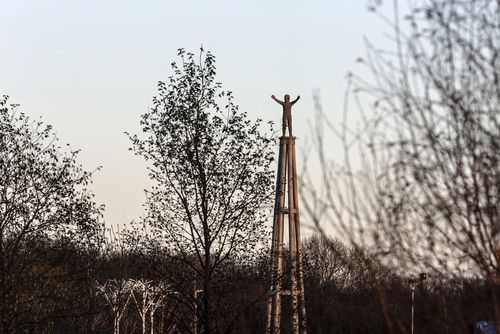The Hope Sculpture, the UK’s first permanent superstructure constructed from 100% cement-free (without CEMI) concrete that incorporates locally sourced aggregates and recycled crushed glass, has been officially launched following a collaborative effort from industry experts to demonstrate a 75% reduction in CO2 for the 23m sculpture compared to a conventional build.
Designed by renowned artist/designer Steuart Padwick in collaboration with over 50 industry leaders, the public art installation across 3 sites in Glasgow is an official COP26 legacy project. The main sculpture is located in Cuningar Loop Woodland Park within Clyde Gateway, Scotland’s largest urban regeneration project, with all those involved in the project working pro-bono to achieve the build in record time.
As well as the 100% cement free concrete, the reduction in emissions was achieved through a combination of using reclaimed materials throughout, such as reclaimed steel gas pipes for the piling, and offsite construction methods to reduce waste and increase efficiencies. The two further sculptures are at Glasgow Central Station and University of Strathclyde. The first constructed from contoured layers of sustainably grown Scottish Sitka Spruce and the second from reclaimed sheet steel with a low carbon 100% cement-free concrete foundation.
Post-COP26, the Hope Sculpture provides a ground-breaking showcase of how the construction industry can help drive the UK net-zero transition through innovative design and construction approaches. With the built environment contributing over 40% of the UK’s carbon emissions, the project has enabled all partners to gather valuable data and insight into future approaches for the construction sector.
Attended by industry leaders, the launch event included an expert industry panel, led by Dr Roddy Yarr Executive Lead for Sustainability at the University of Strathclyde. The panellists included Alan Dowdall, Building Director and low carbon design expert at Ramboll, Jasen Gauld, Technical Sales Director at Aggregate Industries – London Concrete, Neil McKay, Managing Director at regeneration contractor Urban Union, and Michael O’Hagan, Managing Director for Built Environment at Keltbray, who undertook the precast works of the unique columns and did the lifting and installation of the columns and the sculpture.
The panel discussed how they achieved the Hope Sculpture’s 75% carbon reduction and its potential to provide a watershed moment for low carbon construction of the future, as well as the changes needed in the construction and built environment sectors to accelerate Net-Zero delivery.
Designer Steuart Padwick also spoke, alongside Lee Knifton, Director for Scotland & Northern Ireland at the Mental Health Foundation. Knifton talked about the power of art in supporting mental health and the project’s important link to improving mental well-being through our environment. Each sculpture carries mental health signposting nearby.
Upon the unveiling of the installations, Padwick commented: “We all need to address this new global agenda so our young can embrace a future of hope. It is very simple, why would anyone want to poison their future?”
"The most remarkable thing about this project has been collaborating with these companies and individuals. Their integrity, drive and commitment to make a difference has been inspiring." Natalie Alexopoulos, Project Director.
Alan Dowdall, Building Director and low carbon design expert, Ramboll, commented: “Reducing the carbon impact of the construction sector is no longer a ‘nice to have’ but a must have, and innovation is essential in achieving this. The sculptures are an example of just how much can be achieved through a truly collaborative industry effort, and it is now up to us to take these lessons forward and drive sustainable change.”
Michael O’Hagan, Keltbray, Managing Director for Built Environment said: “This project represents a highly significant point of innovation for the sector. Our team has played a vital role in carving the path for industry confidence in this solution, which will undoubtedly help us make an extremely important leap forward in our decarbonisation journey”.
Jasen Gauld, Technical Sales Director, Aggregate Industries - London Concrete commented:
“Our organisation is transforming itself to promote and deliver innovative, low carbon and sustainable building solutions. The ECOPact Max product used is a high strength, green concrete without CEMI, offering a minimum 70% CO2 reduction. For the sculpture, we developed a bespoke ECOPact Max+ product, using 20% recycled glass. The Hope Sculpture actively showcases what can be achieved in concrete foundations, tall visual columns and concrete art sculpture pieces. It sets a very high standard and represents a platform for change.”
Neil McKay, Managing Director, Urban Union, commented: “In addition to playing a role in the net zero agenda, construction plays a vital role in the communities where we work. I hope that this collaboration encourages companies within our sector to see what they can do to inspire and add social value.”
Clyde Gateway’s executive director, Martin McKay, said: “With Glasgow having hosted COP26, I can think of nowhere better for this public art installation, which symbolises the hope of building a greener, healthier future, to call home than the East End of the city - an area that demonstrates that rapid transformations are possible.”
“Communities in Clyde Gateway are used to welcoming global visitors and I am confident they will be just as proud of this legacy of COP26, as they were of previous events.”
In the future, the Hope Sculpture will serve as a beacon of hope and positivity towards reaching global environmental milestones and a reminder of the key role the construction industry has to play in driving the net-zero transition.
The Sculptures
The Hope Sculpture is a landmark 23.5m high installation made using low carbon, recycled and sustainable materials, located in the woodland park of Cuningar Loop, and a part of Clyde Gateway, Scotland’s largest regeneration programme.
The sculpture features an age, gender, race neutral child, embracing the surrounding nature and reaching out to a greener, hopeful future. It stands upon towering elegant 20m high columns, taking their form from Glasgow’s traditional brick chimney stalks but made from an innovative new low-carbon 100% cement free concrete, the UK’s first permanent, cement free concrete superstructure, which paves the way for this pioneering solution. The lighting is soft low energy and respectful of the environment and of local wildlife, using fittings designed and manufactured in Scotland for the Circular Economy.
The 4.5m high Beacon of Hope is located at the city’s architecturally significant Glasgow Central Station, with the Child of Hope reaching out to all those passing through the station. Made from contoured layers of sustainable Scottish-grown Sitka Spruce, it celebrates the expanding timber construction industry that Scotland is developing.
The 3.5m high Hope Triptych at the University of Strathclyde’s Rottenrow Gardens is a playful adaptation of the Child of Hope and composed of three colourful figures, symbolising the power of coming together. The Hope Triptych is made from reclaimed sheet steel with a low carbon 100% cement-free concrete foundation.
Visitors will be encouraged to access the sculptures via a walking and cycling route that connects the pieces.
As well as highlighting the possibilities of sustainability, the sculptures also aim to link our environment with mental well-being and each carries mental health signposting nearby in association with the Mental Health Foundation.
The wide-ranging project also involves words of hope inscribed on the sculptures from local schoolchildren and celebrated writers such as Scotland’s Jackie Kay, Booker winner Douglas Stuart, Ali Smith and Andrew O’Hagan as well as a thought-provoking film ‘A City of Hope’ by Glaswegian BAFTA winner, Hannah Currie.
J&P Building Systems collaborated on the COP26 Hope Sculpture: a showcase for a sustainable future with 75% lower carbon impact. We were pleased to supply H-BAU Rapidobat Cretcon formwork to enable an architectural finish to be achieved on the cement- free concrete support structure for the Hope Sculpture. The cement-free concrete support structure was securely anchored at its foundation using the Pfeifer Column Shoe system.
#hopesculpture #hopetriptych #beaconofhope #COP26Legacy #racetozero

